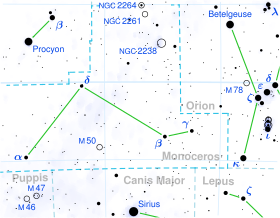| Observation data Epoch J2000 Equinox J2000 | |
|---|---|
| Constellation | Monoceros |
| Right ascension | 06h 01m 50.42241s [1] |
| Declination | −10° 35′ 52.5565″ [1] |
| Apparent magnitude (V) | 4.92 [2] (4.98 + 8.25) [3] |
| Characteristics | |
| Spectral type | B5 III [4] |
| U−B color index | −0.58 [5] |
| B−V color index | −0.12 [5] |
| Astrometry | |
| Radial velocity (Rv) | +39.00 [6] km/s |
| Absolute magnitude (MV) | −1.94 [2] |
| A | |
| Proper motion (μ) |
RA: −8.282
[7]
mas/
yr Dec.: 4.385 [7] mas/ yr |
| Parallax (π) | 4.5717 ± 0.3115 mas [7] |
| Distance | 710 ± 50
ly (220 ± 10 pc) |
| B | |
| Proper motion (μ) |
RA: 6.990
[8]
mas/
yr Dec.: 4.574 [8] mas/ yr |
| Parallax (π) | 3.1006 ± 0.0960 mas [8] |
| Distance | 1,050 ± 30
ly (323 ± 10 pc) |
| Details | |
| 3 Mon A | |
| Mass | 5.85 [9] M☉ |
| Radius | 4.5 [10] R☉ |
| Luminosity | 1,105 [2] L☉ |
| Temperature | 15,000 [9] K |
| Metallicity [Fe/H] | 0.00 [11] dex |
| Rotational velocity (v sin i) | 45 [12] km/s |
| Other designations | |
| Database references | |
| SIMBAD | data |
3 Monocerotis is a binary star [3] system in the equatorial constellation of Monoceros, located approximately 780 light years away from the Sun based on parallax. [1] It is visible to the naked eye as a faint, blue-white hued star with a combined apparent visual magnitude of 4.92. [2] The system is moving further from the Earth with a heliocentric radial velocity of +39 km/s. [6]
The magnitude 4.98 primary, designated component A, has a stellar classification of B5 III, [4] matching an evolved blue giant star. It has 5.85 [9] times the mass of the Sun and is radiating 1,105 [2] times the Sun's luminosity from its photosphere at an effective temperature of 15,000 K. [9] The companion, component B, is magnitude 7.96 with an angular separation of 1.9 ″ from the primary. [14]
References
- ^ a b c Van Leeuwen, F. (2007). "Validation of the new Hipparcos reduction". Astronomy and Astrophysics. 474 (2): 653–664. arXiv: 0708.1752. Bibcode: 2007A&A...474..653V. doi: 10.1051/0004-6361:20078357. S2CID 18759600. Vizier catalog entry
- ^ a b c d e Anderson, E.; Francis, Ch. (2012). "XHIP: An extended hipparcos compilation". Astronomy Letters. 38 (5): 331. arXiv: 1108.4971. Bibcode: 2012AstL...38..331A. doi: 10.1134/S1063773712050015. S2CID 119257644. Vizier catalog entry
- ^ a b Eggleton, P. P.; Tokovinin, A. A. (September 2008), "A catalogue of multiplicity among bright stellar systems", Monthly Notices of the Royal Astronomical Society, 389 (2): 869–879, arXiv: 0806.2878, Bibcode: 2008MNRAS.389..869E, doi: 10.1111/j.1365-2966.2008.13596.x, S2CID 14878976.
- ^ a b Hoffleit, D.; Warren, W. H. (1995). "VizieR Online Data Catalog: Bright Star Catalogue, 5th Revised Ed. (Hoffleit+, 1991)". VizieR On-line Data Catalog: V/50. Originally Published in: 1964BS....C......0H. 5050. Bibcode: 1995yCat.5050....0H.
- ^ a b Mallama, A. (2014). "Sloan Magnitudes for the Brightest Stars". The Journal of the American Association of Variable Star Observers. 42 (2): 443. Bibcode: 2014JAVSO..42..443M. Vizier catalog entry
- ^ a b Gontcharov, G. A. (2006). "Pulkovo Compilation of Radial Velocities for 35 495 Hipparcos stars in a common system". Astronomy Letters. 32 (11): 759–771. arXiv: 1606.08053. Bibcode: 2006AstL...32..759G. doi: 10.1134/S1063773706110065. S2CID 119231169.
- ^ a b c Brown, A. G. A.; et al. (Gaia collaboration) (August 2018). "Gaia Data Release 2: Summary of the contents and survey properties". Astronomy & Astrophysics. 616. A1. arXiv: 1804.09365. Bibcode: 2018A&A...616A...1G. doi: 10.1051/0004-6361/201833051. Gaia DR2 record for this source at VizieR.
- ^ a b c Brown, A. G. A.; et al. (Gaia collaboration) (August 2018). "Gaia Data Release 2: Summary of the contents and survey properties". Astronomy & Astrophysics. 616. A1. arXiv: 1804.09365. Bibcode: 2018A&A...616A...1G. doi: 10.1051/0004-6361/201833051. Gaia DR2 record for this source at VizieR.
- ^ a b c d Hohle, M.M.; Neuhäuser, R.; Schutz, B.F. (2010). "Masses and luminosities of O- and B-type stars and red supergiants". Astronomische Nachrichten. 331 (4): 349. arXiv: 1003.2335. Bibcode: 2010AN....331..349H. doi: 10.1002/asna.200911355. S2CID 111387483. Vizier catalog entry
- ^ Pasinetti Fracassini, L. E.; et al. (February 2001). "Catalogue of Apparent Diameters and Absolute Radii of Stars (CADARS)". Astronomy and Astrophysics. 367 (2) (Third ed.): 521–524. arXiv: astro-ph/0012289. Bibcode: 2001A&A...367..521P. doi: 10.1051/0004-6361:20000451. S2CID 425754.
- ^ Gontcharov, G. A. (2012). "Dependence of kinematics on the age of stars in the solar neighborhood". Astronomy Letters. 38 (12): 771–782. arXiv: 1606.08814. Bibcode: 2012AstL...38..771G. doi: 10.1134/S1063773712120031. S2CID 118345778. Vizier catalog entry
- ^ Abt, Helmut A.; Levato, Hugo; Grosso, Monica (2002). "Rotational Velocities of B Stars". The Astrophysical Journal. 573 (1): 359–365. Bibcode: 2002ApJ...573..359A. doi: 10.1086/340590.
- ^ "3 Mon". SIMBAD. Centre de données astronomiques de Strasbourg. Retrieved 2019-04-12.
- ^ Mason, Brian D.; Wycoff, Gary L.; Hartkopf, William I.; Douglass, Geoffrey G.; Worley, Charles E. (2001). "The 2001 US Naval Observatory Double Star CD-ROM. I. The Washington Double Star Catalog". The Astronomical Journal. 122 (6): 3466. Bibcode: 2001AJ....122.3466M. doi: 10.1086/323920. Vizier catalog entry
